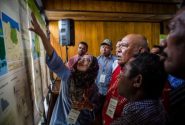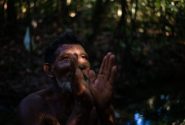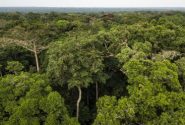
Scientific research has established that children in Africa living in communities where there is more forest cover have higher dietary diversity and more fruit and vegetable consumption up to a certain threshold. CIFOR/Terry Sunderland
BOGOR, Indonesia (6 May, 2013) – Scientists at the Center for International Forestry Research (CIFOR) hope new research will clarify the relationship between tree cover and good child nutrition.
In the following interview, Amy Ickowitz, a development and natural resource economist with CIFOR, explains the goals of CIFOR’s research on trees and child nutrition ahead of the International Conference on Forests for Food Security and Nutrition conference.
The Rome meeting, hosted by the U.N. Food and Agriculture Organization (FAO), will explore the important role forests play in the lives of rural people and the global economy.
Listen to the interview:
Q: The upcoming Forests and Food Security conference in Rome will examine the theme of nutrition and forests. Can you explain what that means and what your work involves?
A: “The topic of food security has been discussed quite a bit in the last few years. The predictions of increases in population and how much food we’re going to need to feed the 9 billion people we’re expecting in the world (by 2050) have really focused a lot on producing enough calories — enough energy to feed the 9 billion people that we’re expecting.
“But there’s another aspect that sometimes doesn’t get quite as much attention, which is the aspect of the quality of food that people need to eat — even for the people that are already living today.
“An important component of that is getting adequate micronutrients — particularly, vitamin A, iron, zinc. Those are important micronutrients that are often lacking in people’s diets, particularly in developing countries.
“I’m a development economist and a natural resource economist, so I look at issues of poverty and the relationship with a natural resource base. I work for CIFOR, the Center for International Forestry Research — where these issues come together: the potential or actual role — is part of what we’re exploring — of forests and their contribution to nutrition.
“Colleagues and myself have recently done some research using data from 21 countries in Africa looking at the diets of children under five and we found that there does seem to be an interesting relationship between tree cover and a couple of nutritional indicators.
“We find that children in Africa that live in communities where there’s more forest cover have higher dietary diversity and more fruit and vegetable consumption up to a certain threshold. So when forest cover gets to be between about 50-60 percent which is really, really dense forest the relationship sort of goes down a bit but up until then — it seems to me that our data is suggesting — the more trees around peoples’ communities, the better the diets of children.
Q: What does that mean?
A: “There are two aspects of ‘what does that mean?’. One aspect is ‘what is driving that relationship, why is that the case?’ The other aspect could possibly be a policy aspect. Our hypothesis is that people that live in communities with more tree cover have more access to forests and forest foods, which tend to be high in vitamin A many of them, so wild fruit and vegetables, those are particularly important, bushmeat can also be an important source of iron, but the data that we used was very coarse data so we can’t really be sure that’s exactly what is happening.
“CIFOR is now initiating a project in five African countries to get a little bit deeper, to interview households to figure out where exactly their foods are coming from — ‘are these the forest foods that we’re hypothesizing that are driving this relationship and does that differ in different kinds of forests?’ — to see if that’s really what’s going on —
“I think what you were getting at with that question: ‘what does this really mean?’ — the message, if our hypothesis is correct, is that forests can be an important component of food security in and of themselves. So often people — especially agronomists and policymakers — talk of forests as if they are kind of an impediment to food security, because if you just want to produce calories to feed people then they’re occupying valuable land that could be used for agriculture, to grow more rice, or other staple crops. What ends up happening is that forests get cleared in the name of food security.
“But we’re saying is that if you look at food security more broadly and take into account food nutrition, the forests themselves may be playing a very important role in food security from the nutritional side of things. This is a really important aspect for policymakers to take into account when they’re planning land use.”
Q: When you speak about enhancing food security through forest food are you speaking about local communities living in forests, or are you talking about a more global project?
A: “Again, I think there are two aspects. One is the kind of thing that we’re hypothesizing that might be driving the relationship — if it’s forest foods, we’re thinking of this as more locally bound, thinking more of small communities, villagers that live in forested areas and the foods that feed them.
“We could be wrong and that’s not what’s driving the relationship — it could be that forests are providing — we think this is one aspect of the issue as well — that forests are also providing ecosystem services for agriculture.
“If that’s the case, it could be that people who live near those forests happen to be lucky because they’re getting straight up close so they’re getting a lot of ecosystem services and making their agriculture more productive, which is allowing them to have more nutritious diets, but (it could also be) that there could be other communities that would be further away that would also be benefiting from those ecosystem services.
“So it still wouldn’t quite be a global thing I think, but it would be more than just local.”
Scientist contact: Amy Ickowitz
CIFOR’s research on forests and nutrition is part of the CGIAR Program on Forests, Trees and Agroforestry and is supported by the UK Department for International Development (DFID) and The Austrian Development Agency.
We want you to share Forests News content, which is licensed under Creative Commons Attribution-NonCommercial-ShareAlike 4.0 International (CC BY-NC-SA 4.0). This means you are free to redistribute our material for non-commercial purposes. All we ask is that you give Forests News appropriate credit and link to the original Forests News content, indicate if changes were made, and distribute your contributions under the same Creative Commons license. You must notify Forests News if you repost, reprint or reuse our materials by contacting forestsnews@cifor-icraf.org.
Further reading
Combating malnutrition and infection with forests - Bronwen Powell
Forest foods should be used in fight against global malnutrition - scientist
Forests, food and nutritional security
CIFOR LIVE BLOG: FAO Forests for Food Security and Nutrition conference
Food consumption on three forest populatioons of the southern coastal area of Cameroon












